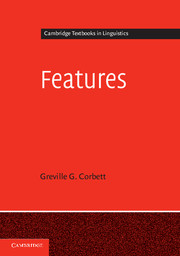Book contents
- Frontmatter
- Contents
- Figures
- Tables
- Preface
- Abbreviations
- 1 Why features?
- 2 Formal perspectives
- 3 Features for different components
- 4 Justifying particular features and their values
- 5 Typology
- 6 Canonical Typology and features
- 7 Determining feature values
- 8 Feature-value mismatches
- 9 Conclusions
- Appendix Standards and implementations
- References
- Author index
- Language index
- Subject index
- References
References
Published online by Cambridge University Press: 05 November 2012
- Frontmatter
- Contents
- Figures
- Tables
- Preface
- Abbreviations
- 1 Why features?
- 2 Formal perspectives
- 3 Features for different components
- 4 Justifying particular features and their values
- 5 Typology
- 6 Canonical Typology and features
- 7 Determining feature values
- 8 Feature-value mismatches
- 9 Conclusions
- Appendix Standards and implementations
- References
- Author index
- Language index
- Subject index
- References
- Type
- Chapter
- Information
- Features , pp. 269 - 309Publisher: Cambridge University PressPrint publication year: 2012



